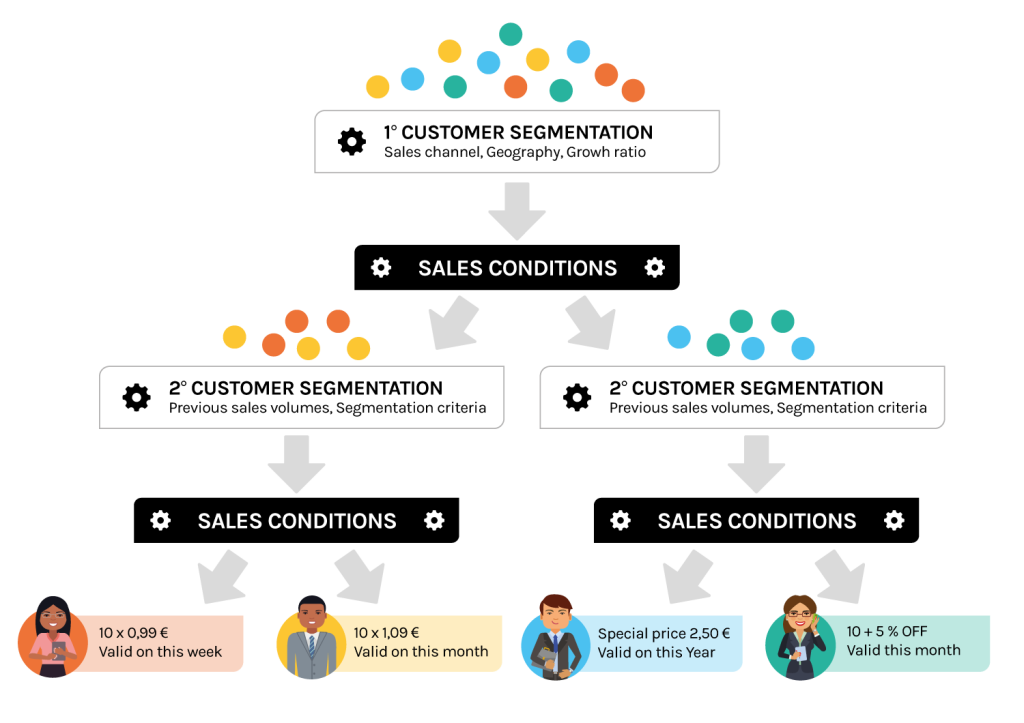Every day several thousand users use our software applications to sell or buy consumer goods.
The technological platform (the ‘engine’) we provide is one, but the contexts and ways in which it is configured are very varied to implement the different pricing strategies of each company.
Below are some representative examples of the considerable variability we observe in our consulting experience.
The most frequently used promotions in B2B that we also know in B2C are those of the ‘buy 5 and get one free product’ type (either part of those 5 or in addition). This type of promo may involve giving away a product homologous to those sold or a different one. It may or may not be applicable for ‘multiples’ e.g. ‘buy 10 and get 2 free products ‘. Sometimes a staggered discount concept is chosen, e.g. ‘if you buy 10 you get 2 freebies, if you buy 20 you get up to 5 freebies’.
Very often the pricing dynamic starts upstream. Marketing defines customer segmentation that takes into account aspects such as sales channel, brand, warehouse (distribution platform from which goods depart), sales volumes and margins previously achieved by customers. Consequently, two customers with the same price list could then have different prices and promotions based on the application of cluster-based rules.
The promotions are usually matched to groups of target products (baskets) and when certain thresholds are reached, the promotions matched to the basket of which the products ordered are part are triggered, and then the software suggests a choice from a basket of ‘benefits’, i.e. products benefiting from a % or quantity discount, with minimum and maximum discount constraints applicable.
The dynamic becomes of the type ‘if you order at least 15 products among products A, B, C and D and at least 3 products D you can get a free gift of 5 products of your choice among E, F, G and B’.
The free quantities can be applied in full or be at the discretion of the seller and be applied automatically in the case of purchase via B2B e-commerce (not seller-mediated).
As mentioned, there may be several promos to which a product competes; in the case of overlapping promos, it is possible to prioritise their application.
A promo can also be binding and therefore, once applied, leaves no possibility of applying others.

Every customer has his or her ‘usual’ price
Often the sale follows ‘the usual’ mode, i.e. what in jargon we call ‘pre-ordering’: the application proposes a customised assortment that remembers the customer’s buying habits and preferences and applies the sales conditions foreseen by zone, commercial network (division of the salesperson or the individual salesperson).
It is also possible to ‘guarantee’ the previous price even if the list price varies from the previous sale to avoid automatisms creating unwanted mechanics on the loyal customer.
The ‘dry’ price cut is a widely used method, especially in sales of food goods, as it can also take into account expiry date, rotation and batch. Often a free percentage discount is assigned to each customer, which can be modified (reduced) by the seller. Or the order is expected to contain one or more defined products on which to make push.
It continues to exist, although it usually starts with a basic price list that is overwritten by one or more ‘offer’ lists. Depending on marketing policies, the price list for a certain agent may not be binding. As already mentioned, the pricing engine based on sales conditions makes it possible to apply a price premium for customer clusters while keeping the same price list.
Some of our customers provide a ‘wallet’ function for the salesperson: this is a consumption budget valid for a certain period of time (typically the sales cycle or sales canvas or campaign) that the salesperson can apply at his discretion during sales. The wallet can be set to allow it to be increased in the event of a sale at a price higher than that automatically applied by the software for that customer-product. The various options can be adjusted and moderated in line with the company’s marketing strategy: for example, it can be tied to a group of products.